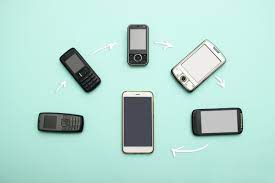Describing the smartphones and its impact on communication
Fast forward to today, and smartphones and its impact have become an integral part of our daily lives, transforming the way we communicate.

Fast forward to today, and smartphones and its impact have become an integral part of our daily lives, transforming the way we communicate, work, and interact with the world.
This blog post will take you on a journey through the evolution of smartphones and explore their profound impact on communication.
The Birth of the Mobile Phone
The story of smartphones begins with the humble mobile phone. In the early 1970s, Martin Cooper, an engineer at Motorola, made the first-ever mobile phone call. Weighing in at a hefty 2.2 pounds, it was hardly a pocket-sized device. Over the next few decades, mobile phones evolved into smaller and more portable devices, but their primary function remained making calls.
The Rise of the Feature Phone
The late 1990s and early 2000s witnessed the rise of feature phones. These devices went beyond simple calling, offering features like text messaging, basic web browsing, and even primitive cameras. While these phones represented a significant leap in mobile communication, they were still a far cry from the smartphones we know today.
The Dawn of the Smartphone Era
The year 2007 marked a watershed moment in the history of communication technology with the introduction of the iPhone by Apple. This sleek device combined a phone, an iPod, and an internet communication device, effectively pioneering the modern smartphone as we know it. With its intuitive touchscreen interface and the App Store, the iPhone changed the game, making smartphones accessible to a broader audience.
The Android Revolution
Not to be outdone, Google introduced the Android operating system in 2008, providing a robust and customizable platform for smartphone manufacturers. This move sparked fierce competition in the industry, leading to rapid advancements in smartphone technology and features. Android-powered devices soon flooded the market, giving consumers a wide range of options to choose from.
The Evolution of Communication Features
As smartphones became more powerful, their communication capabilities evolved dramatically. Let's explore some of the key features that transformed the way we connect with one another:
a. Text Messaging: SMS (Short Message Service) paved the way for instant written communication. It was soon complemented by MMS (Multimedia Messaging Service), allowing users to send pictures and videos.
b. Email on the Go: Smartphones brought our email inboxes to our pockets, enabling us to stay connected to work and personal emails anytime, anywhere.
c. Social Media Integration: Apps like Facebook, Twitter, and Instagram made it effortless to share updates, photos, and videos with friends and family, revolutionizing social interactions.
d. Video Calls: Apps like Skype, FaceTime, and later, Zoom, made face-to-face conversations possible, even when thousands of miles apart.
e. Messaging Apps: The rise of WhatsApp, Telegram, and other messaging apps transformed how we chat with friends, offering features like group chats, voice messages, and end-to-end encryption.
f. Voice Assistants: Siri, Google Assistant, and Alexa brought voice-activated communication and information retrieval to our fingertips.
The Impact on Personal Communication
The advent of smartphones has profoundly influenced personal communication:
a. Accessibility: Smartphones made communication more accessible to people of all ages and abilities. Features like larger text and adjustable font sizes catered to users with visual impairments, while voice commands benefited those with mobility issues.
b. Real-time Connectivity: Smartphones enabled us to stay in touch with loved ones in real-time, bridging geographical gaps and strengthening personal relationships.
c. Multimedia Sharing: The ability to send photos, videos, and voice messages added depth and emotion to our conversations, enhancing the way we express ourselves.
d. Social Integration: Social media apps turned our smartphones into social hubs, allowing us to share our lives and connect with people worldwide.
e. Always On: Smartphones made us perpetually available, blurring the boundaries between work and personal life. While this has its advantages, it has also led to concerns about digital addiction and burnout.
The Impact on Business Communication
The influence of smartphones extends far beyond personal communication. They have also revolutionized the way we conduct business:
a. Remote Work: Smartphones played a pivotal role in the rise of remote work. With email, video conferencing, and cloud-based productivity apps, employees could work from anywhere.
b. Mobile Productivity: Smartphones turned into powerful productivity tools, with features like document editing, task management, and cloud storage, making it possible to handle business tasks on the go.
c. Enterprise Apps: Companies developed custom mobile apps for various functions, from sales and customer service to inventory management, streamlining business processes.
d. Communication Platforms: Slack, Microsoft Teams, and other communication platforms optimized for smartphones facilitated collaboration among teams, even when physically apart.
e. Security Challenges: The ubiquity of smartphones posed security challenges, with the need to protect sensitive business data from theft and cyber threats.
The Future of Smartphone Communication
As we look ahead, the evolution of smartphones and their impact on communication is far from over. Here are some trends and developments to watch for:
a. 5G Technology: The rollout of 5G networks promises faster and more reliable mobile internet connections, enabling smoother video calls, augmented reality experiences, and IoT (Internet of Things) integration.
b. Foldable Phones: Foldable smartphones are on the horizon, offering larger screens for productivity and multitasking while remaining pocket-sized.
c. Augmented and Virtual Reality: AR and VR applications are poised to change how we communicate, offering immersive experiences and new forms of interaction.
d. AI Integration: Artificial intelligence will continue to enhance smartphone features, from personalized virtual assistants to predictive text and image recognition.
e. Privacy and Security: As smartphones store more of our personal and business data, the need for robust privacy and security measures will remain paramount.
f. Environmental Sustainability: Manufacturers are increasingly focusing on eco-friendly materials and sustainable practices to address the environmental impact of smartphone production and disposal.
The evolution of smartphones has been nothing short of remarkable, shaping the way we communicate in our personal lives and revolutionizing the world of business. From humble beginnings as a mere communication device, smartphones have become an integral part of our daily routines, providing us with powerful tools for connection, productivity, and entertainment.
As we continue on this technological journey, it's essential to recognize the profound impact of smartphones on communication and to navigate the challenges and opportunities they present with wisdom and responsibility. The future promises even more exciting developments, and smartphones will undoubtedly remain at the forefront of innovation, redefining the way we connect with one another and the world around us.
What's Your Reaction?
















